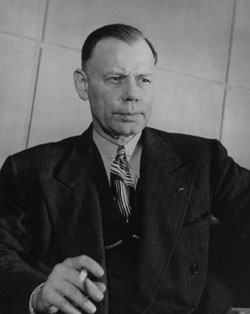- Walter Bedell Smith
Infobox US Ambassador
name=Walter Bedell Smith

imagesize=
order=
ambassador_from=United States
country=Soviet Union
term_start=April 3 ,1946
term_end=December 25 ,1948
predecessor=W. Averell Harriman
successor=Alan G. Kirk
president=Harry S Truman
order2=
title2=4thDirector of Central Intelligence
term_start2=October 7 ,1950
term_end2=February 9 ,1953
president2=Harry S Truman
predecessor2=Roscoe H. Hillenkoetter
successor2=Allen W. Dulles
order3=
title3=Under Secretary of State
term_start3=February 9 ,1953
term_end3=October 1 ,1954
president3=Dwight D. Eisenhower
predecessor3=David K. E. Bruce
successor3=Herbert Hoover, Jr.
birth_date=October 5 ,1895
birth_place=Indianapolis, Indiana
death_date=Death date and age|1961|8|9|1895|10|5|df=yes
death_place=Washington, D.C.
party=
spouse=Mary Eleanor Smith
profession=
religion=
footnotes=General Walter Bedell "Beetle" Smith GBE KCB (October 5 ,1895 –August 9 ,1961 ) wasDwight D. Eisenhower 's Chief of Staff during Eisenhower's tenure atSHAEF and Director of theCIA from 1950 to 1953. He also served as U.S.Ambassador to theSoviet Union from 1946 to 1948.Early Career
Smith at age 16 enlisted in as a private in the Indiana National Guard in 1911. In 1917, after graduating from Officer Candidate Training Camp at Fort Benjamin Harrison, he was commissioned a second lieutenant in the U.S. Army Reserve. Serving during
World War I , he was with the 4th Infantry Division (United States) while in France. In September 1918, he was commissioned a first lieutenant in the Regular Army.Postings between the World Wars included the War Department's Bureau of Military Intelligence, intelligence officer and adjutant for the 37th Infantry Regiment. In 1922, he was adjutant for the 12th Infantry Brigade. From 1925 to 1929, he worked as an assistant in the White House Bureau of the Budget. Back in the army, he served with the 45th Infantry Regiment in the Philippines. He also attended the Infantry School, Command and General Staff School, and the Army War College.
World War II
When General
George C. Marshall became the Army's Chief of Staff, he called in Smith (then a Major) to be Assistant to the Secretary of the General Staff. He became Secretary in September 1941 and in February 1942 was named U.S. Secretary of theCombined Chiefs of Staff . Just before the invasion ofNorth Africa , Marshall sent him toEngland to be Chief of Staff for the European Theater of Operations. In March 1944, Supreme Allied CommanderDwight D. Eisenhower appointed Smith Chief of Staff. He remained in that role untilV-E Day , including making the arrangements for and accepting the surrender of German military forces on May 7, 1945. [ [http://news.bbc.co.uk/onthisday/hi/dates/stories/may/7/newsid_3578000/3578325.stm 1945: Germany signs unconditional surrender] website of the BBC] [Earl F. Ziemke " [http://www.globalsecurity.org/military/library/report/other/us-army_germany_1944-46_index.htm#contents The U.S. Army in the occupation of Germany 1944-1946] " Center of Military History, United States Army, Washington, D. C., 1990, Library of Congress Catalog Card Number 75-619027. [http://www.globalsecurity.org/military/library/report/other/us-army_germany_1944-46_ch15.htm#b3 CHAPTER XV:The Victory Sealed] ]Smith had a reputation as a brusque manager, peppered with salty speech, and was often referred to as Eisenhower's "hatchet man". Such was the case when Gen.
George S. Patton needed to be disciplined, Smith was tasked with delivering the bad news. He was also known to be an avowed segregationist and was oft remarked in writings and private conversations to have doubts about the effectiveness of African-American soldiers in combat. It may be said that Smith was responsible for keeping African-Americans out of most combat roles during World War II while in his influential position as chief of staff to the Supreme Allied Commander, General of the ArmyDwight D. Eisenhower .Post-War Career and Retirement
Smith took leave from the Army to serve as U.S. Ambassador to the Soviet Union from 1946 to 1949. Seeking to return to the United States, he resigned his ambassadorship and in March 1949, he was promoted to General and assumed command of
First United States Army atFort Jay ,Governors Island , New York. In 1950, PresidentHarry S Truman selected him asDirector of Central Intelligence (head of theCentral Intelligence Agency ) where he served until 1953. He retired from the Army upon leaving the DCI position onFebruary 9 ,1953 . [ [https://www.cia.gov/library/center-for-the-study-of-intelligence/csi-publications/books-and-monographs/directors-and-deputy-directors-of-central-intelligence/smith.html Walter Smith] CIA website] He also served asUnder Secretary of State from 1953 to 1954 and played a role in the creation of the National Security Agency.He died from a heart attack on
August 9 ,1961 atWalter Reed Army Hospital in Washington. He was subsequently buried in Section 7 ofArlington National Cemetery . His wife, Mary Eleanor Smith (1893-1963), is buried with him.Various writings by Second World War senior commanders, including, but not limited to
George S. Patton ,Omar Bradley , and others, have tended to portray Smith unfavorably. An effective, ruthless administrator, he is best remembered as being an exceptional professional staff officer, but a man not well-admired by his peers or subordinates.References and notes
Further reading
* [http://www.arlingtoncemetery.net/wbsmith.htm Arlington bio]
* [http://www.army.mil/cmh-pg/books/Last_Salute/Ch20.htm The Last Salute: Civil and Military Funeral, 1921-1969, CHAPTER XX, General Walter Bedell Smith, Special Full Honor Funeral, 9-14 August 1961] by B. C. Mossman and M. W. StarkExternal links
* [http://www.eisenhower.archives.gov/listofholdingshtml/finding_aids_s.html Papers and World War II Documents of Walter Bedell Smith, Dwight D. Eisenhower Presidential Library]
Wikimedia Foundation. 2010.
